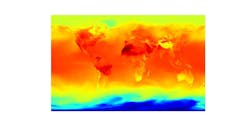NASA and IBM roll out open-source AI model for weather and climate applications
WASHINGTON - IBM in Armonk, N.Y. announced the launch of a new open-source AI foundation model designed for various weather and climate applications. Developed in collaboration with the National Aeronautics and Space Administration (NASA) and Oak Ridge National Laboratory, the model aims to provide a flexible and scalable solution for addressing short-term weather challenges and long-term climate projections.
The new model, detailed in a paper titled "Prithvi WxC: Foundation Model for Weather and Climate," is capable of tackling a wider range of applications than existing weather AI models. It can produce localized forecasts based on local observations, predict severe weather patterns, and enhance the resolution of global climate simulations.
Pre-trained on 40 years of Earth observation data from NASA's Modern-Era Retrospective analysis for Research and Applications, Version 2 (MERRA-2), the foundation model features a unique architecture that allows it to be fine-tuned for different scales: global, regional, and local.
The model is available for download on Hugging Face, along with two specialized versions for specific applications.
One application is climate and weather data downscaling, which involves inferring high-resolution outputs from low-resolution data, such as temperature and precipitation. This model can provide forecasts and projections at up to 12 times higher resolution and is accessible on the IBM Granite page on Hugging Face.
Another application is gravity wave parameterization. Gravity waves are important in various atmospheric processes, yet existing models often struggle to represent them accurately. This model enhances scientists' ability to estimate gravity wave generation, improving the accuracy of numerical weather and climate models.
The model is part of a broader collaboration between IBM Research and NASA to leverage AI in understanding Earth. It joins the Prithvi family of AI foundation models, which includes the previously released geospatial AI foundation model, recognized as the largest open-source model of its kind on Hugging Face. Organizations have utilized this geospatial model to analyze disaster patterns, biodiversity, land use, and other geophysical processes. The weather and climate foundation model, along with the gravity wave parameterization model, can be accessed on the NASA-IBM Hugging Face page, while the downscaling model is available through the IBM Granite Hugging Face page.
About the Author
Jamie Whitney
Senior Editor
Jamie Whitney joined the staff of Military & Aerospace Electronics in 2018 and oversees editorial content and produces news and features for Military & Aerospace Electronics, attends industry events, produces Webcasts, and oversees print production of Military & Aerospace Electronics.
